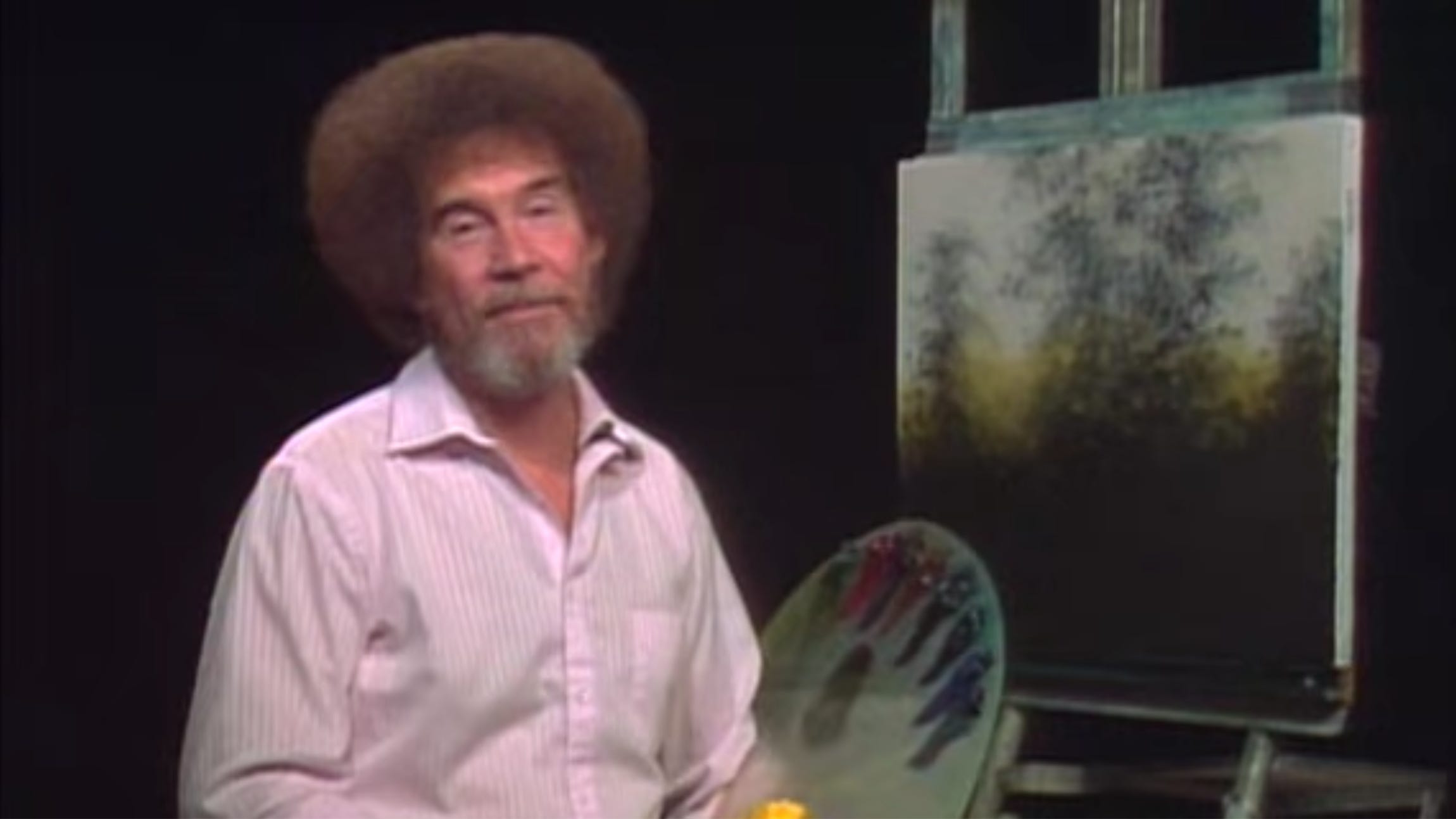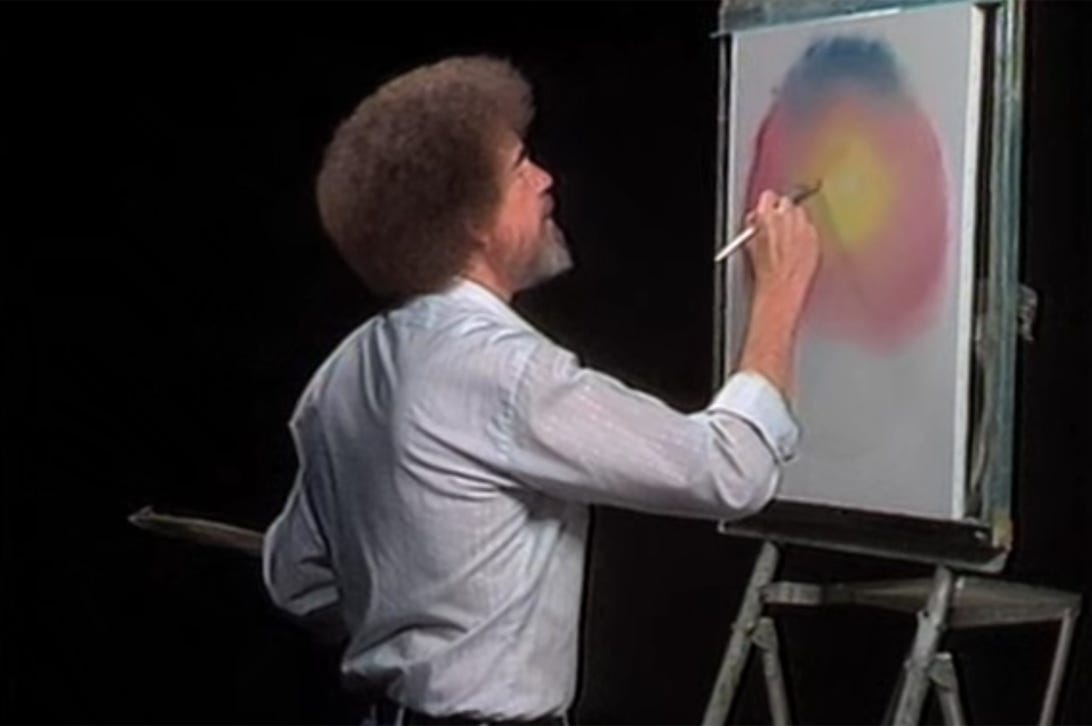
Bob Ross' The Joy of Painting Calms Anxiety One Happy Little Tree at a Time
The long-running PBS series invites viewers to find contentment in the small things

There's a common misconception that in children's entertainment everything needs to be turned up to the extreme — the color, the characters, the action, it's often all so very loud. Subtle and slow are not often words you associate with children's shows. And yet I know for myself, and so many others out there, one of my most beloved childhood pastimes was watchingThe Joy of Paintingwith Bob Ross, which was not targeted specifically toward children but found an eager and captivated audience in young viewers like myself. The series ran on PBS from 1983 to 1994, and thanks to constant reruns, and now streaming, it's always been easy for kids across generations to discover the soothing escape of The Joy of Painting — or for adults to recapture these childhood pleasures even decades later.
I grew up wanting to be an artist and at first thought of Bob Ross as my own personal instructor. As watched him create his majestic landscapes, I studied Ross with a concentration few other shows inspired in me (I was a notorious multitasker even then; you can't blame overexposure to the internet or smartphones for my inability to focus on one thing at a time). Afterward, I tried to put my new skills to use, busting out whatever paints I could find in our craft cabinet and cursing our household for not having a palette so I could squeeze them out into my own little handheld rainbow. After my first thousand attempts to re-create a "happy little tree" failed miserably, the joy of painting was briefly overcome by the frustration of painting. But rather than turn away from the show, bitter in what I then thought of as my failure, I realized what I really had to do was shift my perspective on what "the joy of painting" really meant. The show wasn't a stepping stone to help you achieve something else; the joy was that it could help you find comfort right where you were.
https://www.tvguide.com/news/tv-throwback-best-shows-to-rewatch/">TV Throwback: The Best Shows to Rewatch Right Now
In The Joy of Painting, the whole world was reduced to Ross, his paints, canvas, and all the happy little landscapes brought to life. Unlike other shows I watched as a child, which were filled with eccentric side characters who were constantly barging in, problems to be solved, or lessons to be learned, when I watched The Joy of Painting it was just one man, painting — no bells or whistles, and without even a patterned backdrop to distract me from Ross and his steady process. I had never seen anything like it before, and the simplicity was a balm among so many stresses and stimulations. In the show, there were no real stakes, and if a mistake was made, Ross didn't fret; he calmly found a fix that made you forget that the result wasn't his original intention. It was a show in which failure didn't exist, only "happy little accidents" and a love of trying. As Ross painted hundreds of landscapes throughout the show's run, it was clear that he wasn't trying to create the next great piece of art; he was just enjoying painting, savoring every aspect of the process. In doing so, Ross invited viewers to share in this peaceful pleasure, either through creating a painting of their own or through learning to just appreciate the journey.

Each 30-minute episode of the series was shot in real time, at a stable pace that was reassuring rather than rushed. And when Ross addressed the audience, he did it as though there was only one viewer, creating an intimacy that was compounded by the show's sound design. The show opted out of having an underlying score, and with Ross' mic positioned so close to his face, it's easy to hear his every breath. Combine this with the rhythmic scratching of his brushes against the canvas, and it's not a stretch to consider The Joy of Painting as the forerunner to mainstream ASMR, which provides listeners with a pleasant, low-grade euphoric sensation.
https://www.tvguide.com/news/pee-wees-playhouse-best-80s-childrens-show/">Pee-wee's Playhouse Is Still the Best, Weirdest Children's Show for Kids of All Ages
As he painted, Ross would explain his techniques but also encourage viewers to imagine the stories that could take place within the landscape he was creating. Occasionally, he would paint something — be it a single wave or the sun peeking out from behind a hill — and exclaim his enjoyment at his own creation, seeing the element not just as a few small strokes on a canvas but as something beautiful and worth celebrating in and of itself.
For me, The Joy of Painting will always be defined by its timeless quality (the only glaring evidence of the period it was produced in is the aspect ratio) and its enduring power to recenter even my overactive, anxious mind. It's like a sound machine for the soul, helping me recharge for 30 minutes at a time. Whenever faced with embarking on a daunting new task (or just the dauntingness of trying to get through the day), it's so easy to become overwhelmed by the big picture and feel defeated before you even try. But The Joy of Painting showed that by focusing on one small thing at a time, and finding satisfaction in these little joys, you can achieve a cherished result, whether that be a colorful landscape or simply peace of mind.
The Joy of Painting is available to stream on Netflix, Hulu, Amazon, YouTube, and Tubi. Check out more great '80s series to watch here.
Looking for more shows to stream? Check out TV Guide's TV Throwback, recommending the best shows to rewatch — or to discover for the first time — from 1970 through the present day.

